Each state has designated a specific tree as its state symbol. Here are some images and descriptions of the 50 state trees.
Alabama – Long Leaf Pine
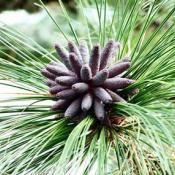
Vast forests of longleaf pine once were present along the southeastern Atlantic coast and Gulf Coast of North America, as part of the eastern savannas. These forests were the source of naval stores – resin, turpentine, and timber – needed by merchants and the navy for their ships. State tree of Alabama and North Carolina.
Alaska – Sitka Spruce
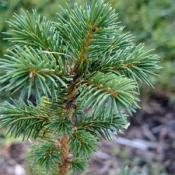
It is by far the largest species of spruce and the fifth-largest conifer in the world (behind giant sequoia, coast redwood, kauri, and western redcedar); and the third-tallest conifer species (after coast redwood and coast Douglas fir). Sitka spruce trees provide good roosting spots for bald eagles and peregrine falcons.
Sitka spruce is used widely in piano, harp, violin, and guitar manufacture, as its high strength-to-weight ratio and regular, knot-free rings make it an excellent conductor of sound. For these reasons, the wood is also an important material for sailboat spars, and aircraft wing spars (including flying models). The Wright brothers’ Flyer was built using Sitka spruce, as were many aircraft before World War II; during that war, aircraft such as the British Mosquito used it as a substitute for strategically important aluminium.
Arizona – Blue Palo Verde
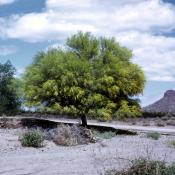
The Palo verde is the official state tree. Its name means green stick and it blooms a brilliant yellow-gold in April or May.
Arkansas – Loblolly Pine
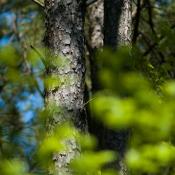
A southern yellow pine. U.S. Forest Service surveys found that loblolly pine is the second-most common species of tree in the United States, after red maple. The word “loblolly” is a combination of “lob”, referring to thick, heavy bubbling of cooking porridge, and “lolly”, an old British dialect word for broth, soup, or any other food boiled in a pot. In the southern United States, the word is used to mean “a mudhole; a mire,” a sense derived from an allusion to the consistency of porridge. Hence, the pine is named as it is generally found in lowlands and swampy areas.
The wood is used for furniture, pulpwood, plywood, composite boards, posts, poles, pilings, crates, boxes, pallets.
California – Giant Sequoia
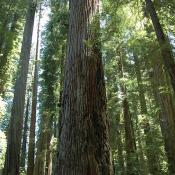
One of three species of coniferous trees known as redwoods, Giant sequoia specimens are the most massive trees on Earth. They grow only in groves on the western slopes of the Sierra Nevada Mountains of California. They grow to an average height of 164–279 ft with trunk diameters ranging from 20–26 ft. They can live up to 3,000 years.
Colorado – Colorado Blue Spruce
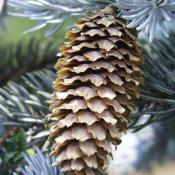
A coniferous evergreen tree. Blue spruce trees are noticeably blue-hued, because of the waxy, powdery layer that is found on the needles. The blue spruce is also the official state tree of Utah.
The Navajo and Keres Native Americans used this tree as a traditional medicinal plant and a ceremonial item, and twigs are given as gifts to bring good fortune. In traditional medicine, an infusion of the needles is used to treat colds and settle the stomach. This liquid is also used externally for rheumatic pains. Early people used their wood for building
Connecticut – White Oak –

White oak has tyloses that give the wood a closed cellular structure, making it water- and rot-resistant. Because of this characteristic, white oak is used by coopers to make wine and whiskey barrels as the wood resists leaking. Also, by federal regulation, bourbon whiskey must be aged in charred new oak (generally understood to mean specifically American white oak)
It has also been used in construction, shipbuilding, agricultural implements, and in the interior finishing of houses. USS Constitution is made of white oak and southern live oak, conferring additional resistance to cannon fire.
State tree of Connecticut, Maryland, and Illinois
Delaware – American Holly
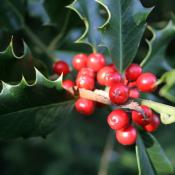
The tree can reach a maximum of 60 feet in height and a trunk diameter of 20 inches.
Florida – Sabal Palm

Sabal is a genus of New World palms, commonly known as palmettos. They are fan palms. Sabal Palms are also known as cabbage-palm, palmetto, and swamp cabbage.
Sabal palms are extremely salt-tolerant (can even grow where washed by sea water at high tide) and are often seen growing near the Atlantic ocean coast. The tree produces the palm heart which is used in heart of palm salad but harvesting the palm heart kills the tree. This tree is the state symbol of Florida and South Carolina.
Georgia – Southern Live Oak
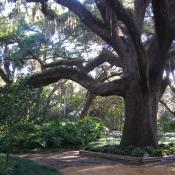
Live oak wood is hard, heavy, and difficult to work with, but very strong. In the days of wooden ships, live oaks were the preferred source of the framework timbers of the ship, using the natural trunk and branch angles for their strength. The frame of USS Constitution was constructed from southern live oak wood harvested from St. Simons Island, Georgia, and the density of the wood grain allowed it to survive cannonade, thus earning her the nickname “Old Ironsides”. Even today, the U.S. Navy continues to own extensive live oak tracts.
Hawaii – Candlenut Tree
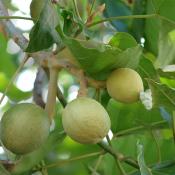
A flowering tree also called the kukui tree. The nut is often used cooked in Indonesian and Malaysian cuisine, where it is called kemiri in Indonesian or buah keras in Malay. On the island of Java in Indonesia, it is used to make a thick sauce that is eaten with vegetables and rice. In ancient Hawaiʻi, kukui nuts were burned to provide light. The nuts were strung in a row on a palm leaf midrib, lit on one end, and burned one by one every 15 minutes or so. This led to their use as a measure of time. Hawaiians also extracted the oil from the nut and burned it in a stone oil lamp called a kukui hele po (light, darkness goes) with a wick made of kapa cloth. Because the seeds contain saponin and phorbol, they are mildly toxic when raw. In Maui, the kukui is a symbol of enlightenment, protection, and peace.
Idaho – Western White Pine
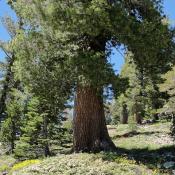
The western white pine tree grows in the mountains of the western United States and Canada (in the Sierra Nevada, the Cascade Range, the Coast Range, and the northern Rocky Mountains), extending down to sea level in many areas. Western white pine wood is soft, straight-grained, and evenly textured (used to make everything from houses to wooden matches).
Illinois – White Oak

White oak has tyloses that give the wood a closed cellular structure, making it water- and rot-resistant. Because of this characteristic, white oak is used by coopers to make wine and whiskey barrels as the wood resists leaking. Also, by federal regulation, bourbon whiskey must be aged in charred new oak (generally understood to mean specifically American white oak)
It has also been used in construction, shipbuilding, agricultural implements, and in the interior finishing of houses. USS Constitution is made of white oak and southern live oak, conferring additional resistance to cannon fire. State tree of Connecticut, Maryland, and Illinois
Indiana – Tulip Poplar
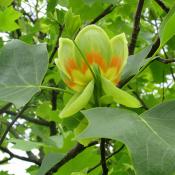
The tulip poplar (Liriodendron Tulipifera) was designated the official state tree of Indiana in 1931 (Tennessee and Kentucky also recognize tulip poplar as their official tree symbol).
The tulip poplar is not actually a poplar tree, but a member of the magnolia family. The tulip poplar leaf has a unique, distinct shape (it appears in the border of the Indiana state seal), and produces huge, bell-shaped greenish-yellow with orange flowers in the spring.
Also called yellow poplar, tulip tree, or canoe tree (because Native Americans used it to make dugout canoes), tulip poplars can be found throughout the state of Indiana.
Iowa – Bur Oak
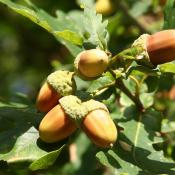
The oak tree was chosen by the 59th Iowa General Assembly as Iowa’s official tree on March 13, 1961. Although Iowa did not designate a specific species of oak as its state tree, many people recognize bur oak, (Fagaceae Quercus macrocarpa,) as the state tree since it is the most widespread species in the state. The oak tree became the State Tree of Iowa in 1961 as a symbol of strength. There are 12 species of oak trees native to Iowa including pin, swamp white, black, red, chinkapin, blackjack, post and bur. Oak trees an important part of the ecosystem as a variety of wildlife feed on the acorns. Oaks are also an important timber species.
Kansas – Eastern Cottonwood
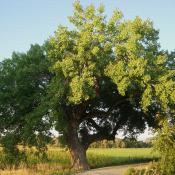
A type of poplar, widely used for pulpwood. and for the manufacture of paper.
It is also sold as inexpensive hardwood timber, used for pallets and cheap plywood; more specialized uses include matchboxes and the boxes in which Camembert cheese is sold.
Poplar wood is also widely used in the snowboard industry for the snowboard core, because it has exceptional flexibility, and is sometimes used in the bodies of electric guitars and drums, to produce chopsticks or wooden shoes. State tree of Nebraska and Kansas
Kentucky – Tulip Tree
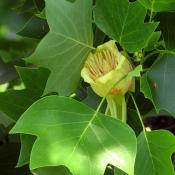
The tulip poplar is not actually a poplar tree, but a member of the magnolia family. The tulip poplar leaf has a unique, distinct shape (it appears in the border of the Indiana state seal), and produces huge, bell-shaped greenish-yellow with orange flowers in the spring.
The tulip poplar is the tallest eastern hardwood tree and produces large tulip-like flowers in the spring which have a delightful fragrance of nectar that even attracts birds (including ruby-throated hummingbirds).
The wood of the North American species (called poplar or tulipwood) is fine grained and stable. It is easy to work and commonly used for cabinet and furniture framing, i.e. internal structural members and subsurfaces for veneering. Additionally, much inexpensive furniture, described for sales purposes simply as “hardwood”, is in fact primarily stained poplar. In the literature of American furniture manufacturers from the first half of the 20th century, it is often referred to as “gum wood”. The wood is only moderately rot-resistant and is not commonly used in shipbuilding, but has found some recent use in light-craft construction.
The name canoewood probably refers to the tree’s use for construction of dugout canoes by eastern Native Americans, for which its fine grain and large trunk size is eminently suited. State tree of Indiana, Tennessee, and Kentucky
Louisiana – Bald Cypress
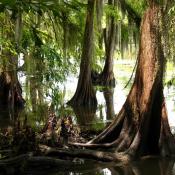
Bald cypresses are long-lived and slow-growing; old trees are usually hollow. Unlike most conifers (which are evergreens), the bald cypress is deciduous (it loses its needles in the fall – giving the tree a “bald” appearance). A majestic tree that grows in many parts of Louisiana, particularly in swampy areas. Cypress wood is very resistant to decay and the wood is considered valuable for a variety of products.
Maine – Eastern White Pine
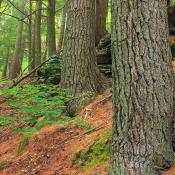
Henry David Thoreau said “There is no finer tree.”
In the 19th century, the harvesting of Midwestern white pine forests played a major role in America’s westward expansion through the Great Plains. A quarter million white pines were harvested and sent to lumber yards in Chicago in a single year. Although eastern white pine was frequently used for flooring in buildings constructed before the U.S. Civil War, the wood is soft and will tend to cup over time with wear. George Washington opted for the much harder southern yellow pine at Mount Vernon instead. During colonial times, its strong, straight trunks were used to make masts for ships sailing in the British Royal Navy. Also state tree of Michigan.
Maryland – White Oak –

White oak has tyloses that give the wood a closed cellular structure, making it water- and rot-resistant. Because of this characteristic, white oak is used by coopers to make wine and whiskey barrels as the wood resists leaking. Also, by federal regulation, bourbon whiskey must be aged in charred new oak (generally understood to mean specifically American white oak)
It has also been used in construction, shipbuilding, agricultural implements, and in the interior finishing of houses. USS Constitution is made of white oak and southern live oak, conferring additional resistance to cannon fire. State tree of Connecticut, Maryland, and Illinois
Massachusetts – American Elm
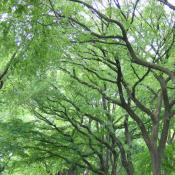
The American elm is a deciduous hermaphroditic tree. Dutch elm disease is a fungal disease that has ravaged the American elm, causing catastrophic die-offs. It has been estimated that only approximately 1 in 100,000 American elm trees is Dutch elm disease-tolerant, most known survivors simply having escaped exposure to the disease. The American elm’s wood is coarse, hard, and tough, with interlacing, contorted fibers that make it difficult to split or chop, and cause it to warp after sawing. Accordingly, the wood originally had few uses, save for making hubs for wagon wheels
Michigan – Eastern White Pine
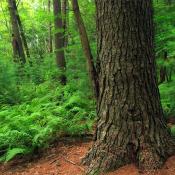
There was a time in colonial history, when the White Pine was reserved for the British Royal Navy and were actually marked by blazing a broad arrow on the trunk declaring them to be the ‘Kingstrees’! White Pine were extensively transported to Britain aboard barge-like vessels. The masts that adorn the US Constitution (Old Ironsides) were actually designed from single trees and laminated to withstand cannon ball impacts. This practice was another source of friction between the English and the colonials. All through the American Revolution, the favorite indulgence of the patriots was to see how many of the ‘Kingstrees’ a single man could ax and haul. Also state tree of Maine
Minnesota – Red Pine or Norway Pine
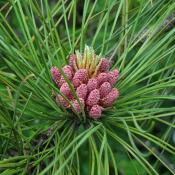
Minnesota is the only state to refer to the red pine as a Norway pine. Commonly called Norway pine, legislation noted “the sturdiness and majesty of the tree, and how it helped lay the foundation for the wealth of Minnesota.”
Mississippi – Southern Magnolia Tree –
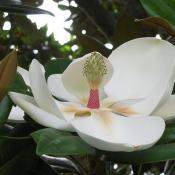
One type of magnolia tree, the cucumbertree, grows to large size and is harvested as a timber tree in northeastern US forests. Its wood is sold as “yellow poplar” along with that of the tuliptree. The Fraser magnolia also attains enough size sometimes to be harvested, as well.
Missouri – Flowering Dogwood –
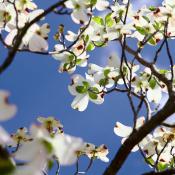
This species has in the past been used in the production of inks, scarlet dyes, and as a quinine substitute. The hard, dense wood has been used for products such as golf club heads, mallets, wooden rake teeth, tool handles, jeweler’s boxes and butcher’s blocks. It is the state tree and flower of Virginia, the state tree of Missouri, and state flower of North Carolina. It was used to treat dogs with mange, which may be how it got its name. The red berries are edible, but do not taste good.
In 1915, forty dogwood saplings were donated by U.S. to Japan in the 1912-15 exchange of flowers between Tokyo and Washington, D.C. While the cherry trees survived the ensuing sour relations of these two countries and are the main feature of the National Cherry Blossom Festival, all dogwood trees in Tokyo died except the one that had been planted in an agriculture high school. In 2012, the United States sent 3,000 dogwood saplings to Japan to commemorate the 100 year anniversary of the Washington D.C. cherry trees given as a gift to the U.S. by Japan in 1912.
Montana – Ponderosa Pine
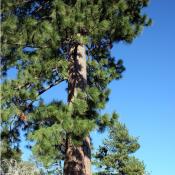
also known as the yellow pine It is the most widely distributed pine species in North America. The bark has a distinctive scent of vanilla or butterscotch.
This stately western Montana resident has figured heavily in the development of all the West. American Indians traditionally ate the seeds and inner bark, dug out logs for canoes, and used the pitch as waterproofing and ointment.
Nebraska – Eastern Cottonwood
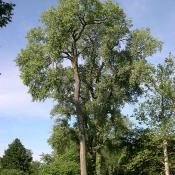
Nebraska designated the cottonwood as the official state tree in 1972, replacing the original choice made in 1937 – the American elm.
A type of poplar, widely used for pulpwood. and for the manufacture of paper.
It is also sold as inexpensive hardwood timber, used for pallets and cheap plywood; more specialised uses include matchboxes and the boxes in which Camembert cheese is sold.
Poplar wood is also widely used in the snowboard industry for the snowboard core, because it has exceptional flexibility, and is sometimes used in the bodies of electric guitars and drums, to produce chopsticks or wooden shoes. State tree of Nebraska and Kansas
Nevada – Single-leaf Pinyon or Great Basin Bristlecone pine
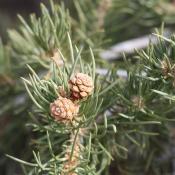
From Nevada Legislature: “The bristlecone pine (Pinus longaeva) is the oldest living thing on Earth, with some specimens in Nevada more than 4,000 years old. The tree can be found at high elevations.
Single-leaf pinyon is one of the State Tree of Nevada. Pinus monophylla is the scientific name of white pine and it is commonly known as Single Leaf Piñon, Single Leaf Pinyon Pine, Stone Pine, Pine Pinyon, also called pinyon, nut pine, one-leaf pine, and piñon in Spanish language. Pinus are the genus of the white pine and P. monophylla is its species. The Nevada’s State tree Single-leaf pinyon is belongs from the family of Pinaceae, which is native to the United States and northwest Mexico. The pinyon or piñon pine group grows in the southwestern United States, especially in New Mexico, Arizona, and Utah. The trees yield edible nuts, (pine nuts) which are a staple of the Native Americans, and still widely eaten as a snack and as an ingredient in New Mexican cuisine. It takes three years for the piñon to form cones with nuts inside…but the cycle is moisture dependent.
New Hampshire – American White Birch – aka paper birch or canoe birch.
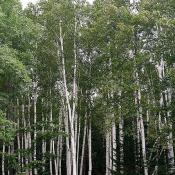
While paper birch does not have a very high overall economic value, it is used in furniture, flooring, popsicle sticks. The wood can also be made into spears, bows, arrows, snowshoes, sleds and other items. Its bark is an excellent fire starter; it ignites at high temperatures even when wet.
It is the provincial tree of Saskatchewan and the state tree of New Hampshire
New Jersey – Northern Red Oak
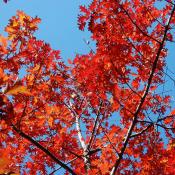
It is also the state tree of New Jersey and the provincial tree of Prince Edward Island. The northern red oak is one of the most important oaks for timber production in North America. Quality red oak is of high value as lumber and veneer, while defective logs are used as firewood. Other related oaks are also cut and marketed as red oak, although their wood is not always of as high a quality. These include eastern black oak, scarlet oak, pin oak, Shumard oak, southern red oak and other species in the red oak group. Construction uses include flooring, veneer, interior trim, and furniture. It is also used for lumber, railroad ties, and fence posts.
Red oak wood grain is so open that smoke can be blown through it from end-grain to end-grain on a flat-sawn board. For this reason, it is subject to moisture infiltration and is unsuitable for outdoor uses such as boatbuilding or exterior trim.
The northern red oak is named for the reddish color of the wood, though the fall foliage can also be a brilliant red. The acorns, leaves, and seedlings of northern red oak provide food for a huge array of wildlife including many species of birds, deer, elk, bear, squirrels, rabbits, and rodents.
An important source of hardwood lumber, the coarse-grained wood of the northern red oak tree is hard, strong, heavy, and durable. Red oak wood has been used to make railroad ties, fence posts, furniture, flooring, and for many other uses (it is also an excellent firewood).
New Mexico – Piñon Pine
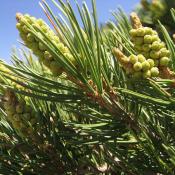
The pinyon or piñon pine group grows in the southwestern United States, especially in New Mexico, Arizona, and Utah. The trees yield edible nuts, (pine nuts) which are a staple of the Native Americans, and still widely eaten as a snack and as an ingredient in New Mexican cuisine. It takes three years for the piñon to form cones with nuts inside…but the cycle is moisture dependent.
New York – Sugar Maple
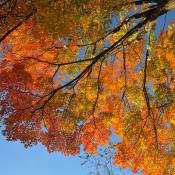
Sugar maple is best known for its bright fall foliage and for being the primary source of maple syrup. It takes 40 parts of maple sap to produce only 1 part of pure syrup. The wood from the sugar maple tree is used for making bowling alleys and bowling pins; basketball courts, including the floors used by the NBA; and baseball bats. It is also widely used in the manufacture of musical instruments, such as the members of the violin family (sides and back), guitars (neck), and drum shells.
North Carolina – Long leaf pine

Long-leaf Pine – Vast forests of longleaf pine once were present along the southeastern Atlantic coast and Gulf Coast of North America, as part of the eastern savannas. These forests were the source of naval stores – resin, turpentine, and timber – needed by merchants and the navy for their ships. State tree of Alabama and North Carolina.
North Dakota – American Elm
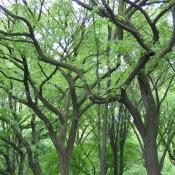
The American elm is a deciduous hermaphroditic tree. Dutch elm disease is a fungal disease that has ravaged the American elm, causing catastrophic die-offs. It has been estimated that only approximately 1 in 100,000 American elm trees is Dutch elm disease-tolerant, most known survivors simply having escaped exposure to the disease. The American elm’s wood is coarse, hard, and tough, with interlacing, contorted fibers that make it difficult to split or chop, and cause it to warp after sawing. Accordingly, the wood originally had few uses, save for making hubs for wagon wheels.
Ohio – Buckeye
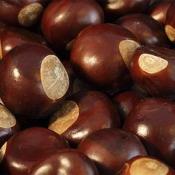
Native Americans noticed that the nuts resembled the brown, large shape of deer eyes, which is why Ohio is now known as the Buckeye State. Native Americans would blanch buckeye nuts, extracting the tannic acid for use in making leather. The nuts can also be dried, turning dark as they harden with exposure to the air, and strung into necklaces similar to those made from the kukui nut in Hawaii.
Oklahoma – Eastern Redbud
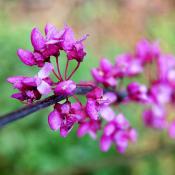
Known as the harbinger of spring, the eastern redbud’s delicate blossoms and buds are one of the season’s most dramatic displays. But this tree’s beauty doesn’t end with its flowery show. Unique and irregular branching patterns combine with a trunk that commonly divides close to the ground to create a very handsome, spreading and often flat-topped crown. Redbud tree is also known as Judas tree. According to the legend, Judas Iscariot hanged himself on the Redbud Tree after he betrayed Christ. Since it was ashamed, Redbud tree changed the color of the bloom from white to red.
Redbud Tree is especially important for the people of Israel, where it has status of protected tree.
Hard wood of Redbud tree is used in the production of veneers.
Flowers, buds and pods are edible. Flowers and buds are harvested at the beginning of the spring, and pods at the beginning of summer. Flowers have sweet or slightly acidic taste. They can be used raw (in the form of salads) or pickled.
Root of redbud tree contains substances that are used for the production of red dyes.
Oregon – Douglas fir
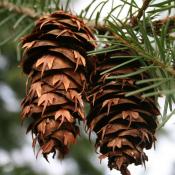
At 329 feet the Coast Douglas-Fir in Oregon is considered the tallest tree in the state. Also known as the Douglas Spruce or the Oregon Pine tree. Because of the massive size of the tree, the wood or lumber from the tree is highly valued. It is used for lumber and plywood and also makes excellent wood fuel.
Pennsylvania – Eastern Hemlock
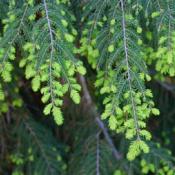
The lumber is used for general construction and crates. Because of its unusual power of holding spikes, it is also used for railroad ties. What the questioner has in mind, of course, is the fact that the Athenian philosopher Socrates is said to have committed suicide by ingesting a drink made from poison hemlock. Insofar as I am aware, however, hemlock trees aren’t toxic — and they don’t grow in Greece.
The poison hemlock associated with Socrates is an herbaceous plant (Conium maculatum) in the carrot family. Mentioned in the Bible, it’s a native of Eurasia that has been naturalized in the Western Hemisphere since colonial times. The Hemlock produces some of the smallest cones in the pine family.
Rhode Island – Red Maple
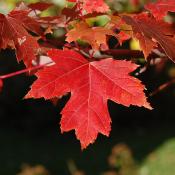
Acer rubrum, the red maple, also known as swamp, water or soft maple, is one of the most common and widespread deciduous trees of eastern and central North America. The U.S. Forest service recognizes it as the most abundant native tree in eastern North America. The leaves of red maple, especially when dead or wilted, are extremely toxic to horses. About 50% to 75% of affected horses die or are euthanized as a result.
It is one of the first trees to change color. The sap can be used to make maple syrup, though it’s not as high quality as that of sugar maples. Its wood is used for inexpensive furniture, firewood and railroad ties.
South Carolina – Sabal Palm

Sabal is a genus of New World palms, commonly known as palmettos. They are fan palms. Sabal Palms are also known as cabbage-palm, palmetto, and swamp cabbage.
Sabal palms are extremely salt-tolerant (can even grow where washed by sea water at high tide) and are often seen growing near the Atlantic ocean coast. The tree produces the palm heart which is used in heart of palm salad but harvesting the palm heart kills the tree. This tree is the state symbol of Florida and South Carolina.
South Dakota – Black Hills Spruce
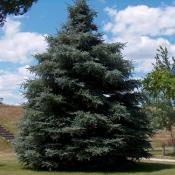
The Black Hills spruce is a variety of the more widespread white spruce found naturally only in southwest South Dakota and a small portion of northeast Wyoming. While not as widely known as other spruces, this ornamental spruce can be planted just about anywhere that the more common Colorado spruce will grow.
Tennessee – Tulip Tree
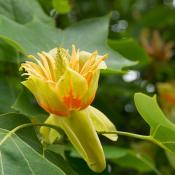
The tulip poplar (Liriodendron Tulipifera) was recognized as the official state tree of Tennessee in 1947. Tennessee also recognizes eastern red cedar (evergreen tree) and the yellowwood (bicentennial tree) as symbols of the state.
(Indiana and Kentucky also recognize tulip poplar as their official tree symbol).
According to the Tennessee Blue Book; “The tulip poplar was chosen because it grows from one end of the state to the other” and “was extensively used by the pioneers of the state to construct houses, barns, and other necessary farm buildings.”
The tulip poplar is not actually a poplar tree, but a member of the magnolia family.
Texas – Pecan
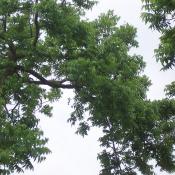
The pecan is a species of hickory native to northern Mexico and the southern United States in the region of the Mississippi River. The seed is an edible nut used as a snack and in various recipes, such as praline candy and pecan pie. Pecan is the state nut of Alabama, Arkansas, California, and Texas. Pecan wood is used in making furniture and wood flooring,[28] as well as a flavoring fuel for smoking meats, giving grilled foods a sweet and nutty flavor stronger than many fruit woods. Thomas Jefferson planted pecan trees, C. illinoinensis (Illinois nuts), in his nut orchard at his home, Monticello, in Virginia. George Washington reported in his journal that Thomas Jefferson gave him “Illinois nuts”, pecans, which Washington then grew at Mount Vernon, his Virginia home.
Utah – (blue spruce until 2014) – Quaking Aspen
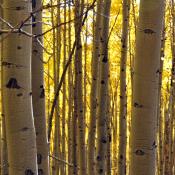
The quaking aspen (Populus tremuloides) was chosen by the Utah State Legislature in 2014 to be the state tree. The quaking aspen replaced the Colorado blue spruce, which had held the honor of state tree since 1933. The quaking aspen, which is also known as trembling aspen, makes up about 10% of the forest cover in the State of Utah and can be found in all of Utah’s 29 counties. In comparison, the Colorado blue spruce makes up about 1% of the forest cover and is primarily found in the the Wasatch and Uinta mountains.
This deciduous tree belongs to the willow family. Its name originates from the lightweight shiny leaves that quake and tremble when moved by even the gentlest breeze. Do not plant these trees near buildings, driveways and sidewalks because they produce large roots near the surface of the ground. The roots will invade any crack or flaw in foundations and cement structures as the tree grows.
One group of these trees in Utah (called Pando) may be the largest single organism in the world. As I said these trees reproduce using root suckers. This means that the new trees are all clones of the original tree. This makes them one single organism. Back in 1976 scientists estimated that Pando consisted of 47,000 trees that were clones.
Vermont – Sugar Maple

Sugar maple is best known for its bright fall foliage and for being the primary source of maple syrup. It takes 40 parts of maple sap to produce only 1 part of pure syrup. The wood from the sugar maple tree is used for making bowling alleys and bowling pins; basketball courts, including the floors used by the NBA; and baseball bats. It is also widely used in the manufacture of musical instruments, such as the members of the violin family (sides and back), guitars (neck), and drum shells.
Virginia – Flowering Dogwood
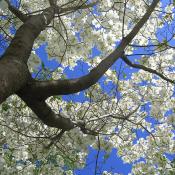
– This species has in the past been used in the production of inks, scarlet dyes, and as a quinine substitute. The hard, dense wood has been used for products such as golf club heads, mallets, wooden rake teeth, tool handles, jeweler’s boxes and butcher’s blocks. It is the state tree and flower of Virginia, the state tree of Missouri, and state flower of North Carolina. It was used to treat dogs with mange, which may be how it got its name. The red berries are edible, but do not taste good.
In 1915, forty dogwood saplings were donated by U.S. to Japan in the 1912-15 exchange of flowers between Tokyo and Washington, D.C. While the cherry trees survived the ensuing sour relations of these two countries and are the main feature of the National Cherry Blossom Festival, all dogwood trees in Tokyo died except the one that had been planted in an agriculture high school. In 2012, the United States sent 3,000 dogwood saplings to Japan to commemorate the 100 year anniversary of the Washington D.C. cherry trees given as a gift to the U.S. by Japan in 1912.
Washington – Western Hemlock
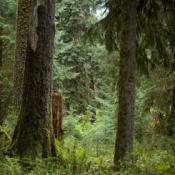
Although it isn’t as strong as Douglas Fir, nor rot-resistant like Red Cedar, Western Hemlock still finds use as a building material and as a pulpwood for paper. For the First Nations peoples Western Hemlock was an important plant, more often used to make tools and cooking implements rather than as a building material. In some ancient North American traditions, western hemlock was an important herb for women. Among the Kwakwaka’wakw people, female warriors made head dresses from western hemlock, for ceremonial dances. ates. Because of its unusual power of holding spikes, it is also used for railroad ties. What the questioner has in mind, of course, is the fact that the Athenian philosopher Socrates is said to have committed suicide by ingesting a drink made from poison hemlock. Insofar as I am aware, however, hemlock trees aren’t toxic — and they don’t grow in Greece.
The poison hemlock associated with Socrates is an herbaceous plant (Conium maculatum) in the carrot family. Mentioned in the Bible, it’s a native of Eurasia that has been naturalized in the Western Hemisphere since colonial times. The Hemlock produces some of the smallest cones in the pine family.
West Virginia – Sugar Maple

Sugar maple is best known for its bright fall foliage and for being the primary source of maple syrup. It takes 40 parts of maple sap to produce only 1 part of pure syrup. The wood from the sugar maple tree is used for making bowling alleys and bowling pins; basketball courts, including the floors used by the NBA; and baseball bats. It is also widely used in the manufacture of musical instruments, such as the members of the violin family (sides and back), guitars (neck), and drum shells. State tree of West Virginia and of Wisconsin.
Wisconsin – Sugar Maple

Sugar maple is best known for its bright fall foliage and for being the primary source of maple syrup. It takes 40 parts of maple sap to produce only 1 part of pure syrup. The wood from the sugar maple tree is used for making bowling alleys and bowling pins; basketball courts, including the floors used by the NBA; and baseball bats. It is also widely used in the manufacture of musical instruments, such as the members of the violin family (sides and back), guitars (neck), and drum shells. State tree of West Virginia and of Wisconsin.
Wyoming – Plains Cottonwood
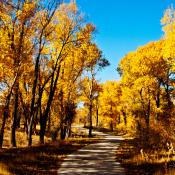
The plains cottonwood is a large, fast-growing, short-lived tree of the Great Plains and eastern border of the Rocky Mountains. Members of the willow family, cottonwoods are named for the cotton-like mass of hairs surrounding their seeds. They are related to poplars and aspens.
The plains cottonwood has been very useful to man. The wood is light weight and easy to handle. It was used as a construction material and burned for heat by American Indians and American pioneers. Due to its abundance, lumber from it was used to build barns and houses. During the winter of 1804 the Indians taught Lewis and Clark how to make canoes by hollowing out large trunks of plains cottonwoods. The bark, twigs, young branches and saplings were also used as forage for horses. The inner bark contains salicin and can be used as an anti-rheumatic drug, disinfectant and antiseptic. Its pulp is used to make paper products and wood for making light furniture and pallets. Plains cottonwoods are used in shelterbelts and wildlife plantings. Hollow trees make ideal den sites for wildlife. Young trees, young branches and twigs are used for food by deer, mice, beaver and grouse.
Farmforum.net
